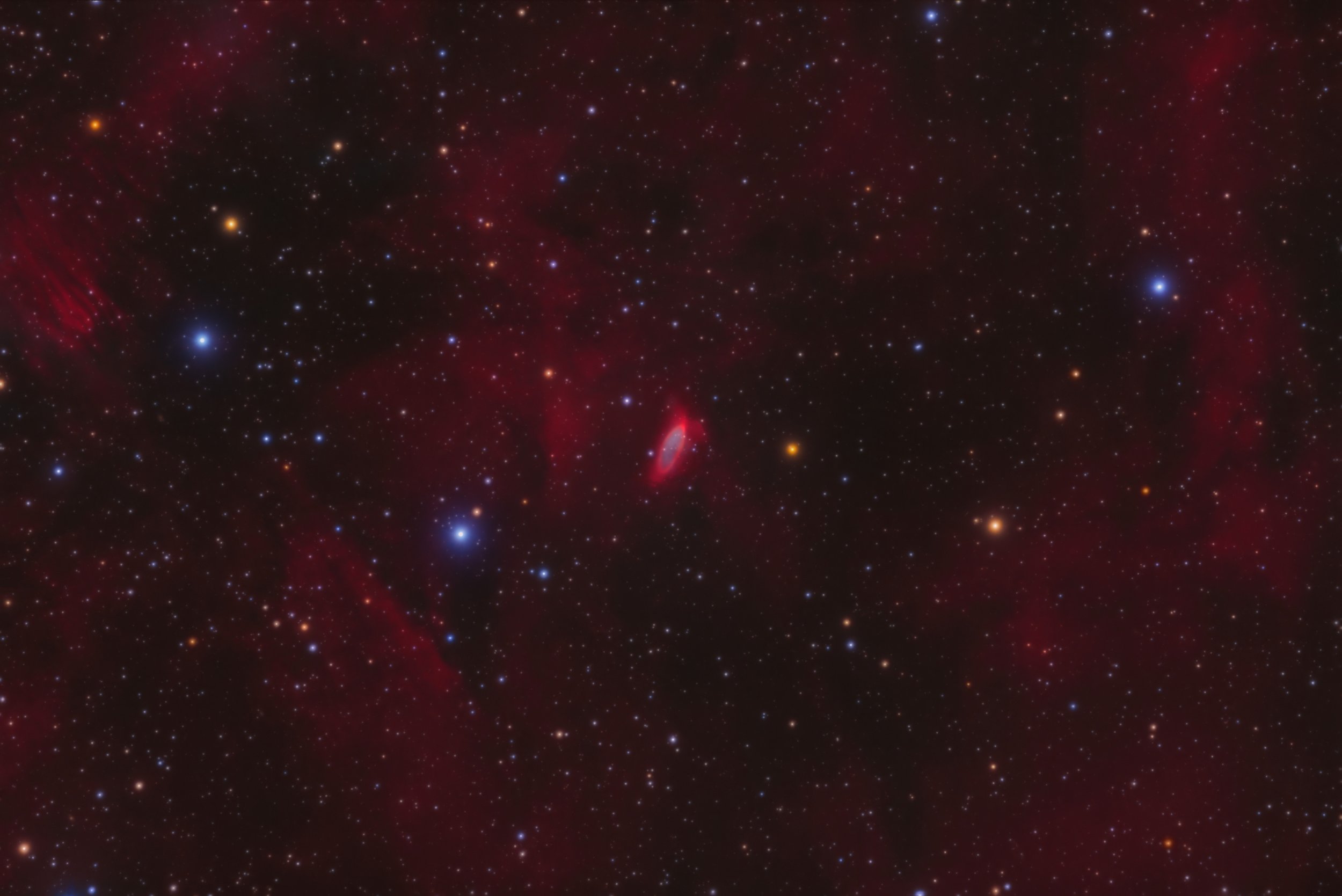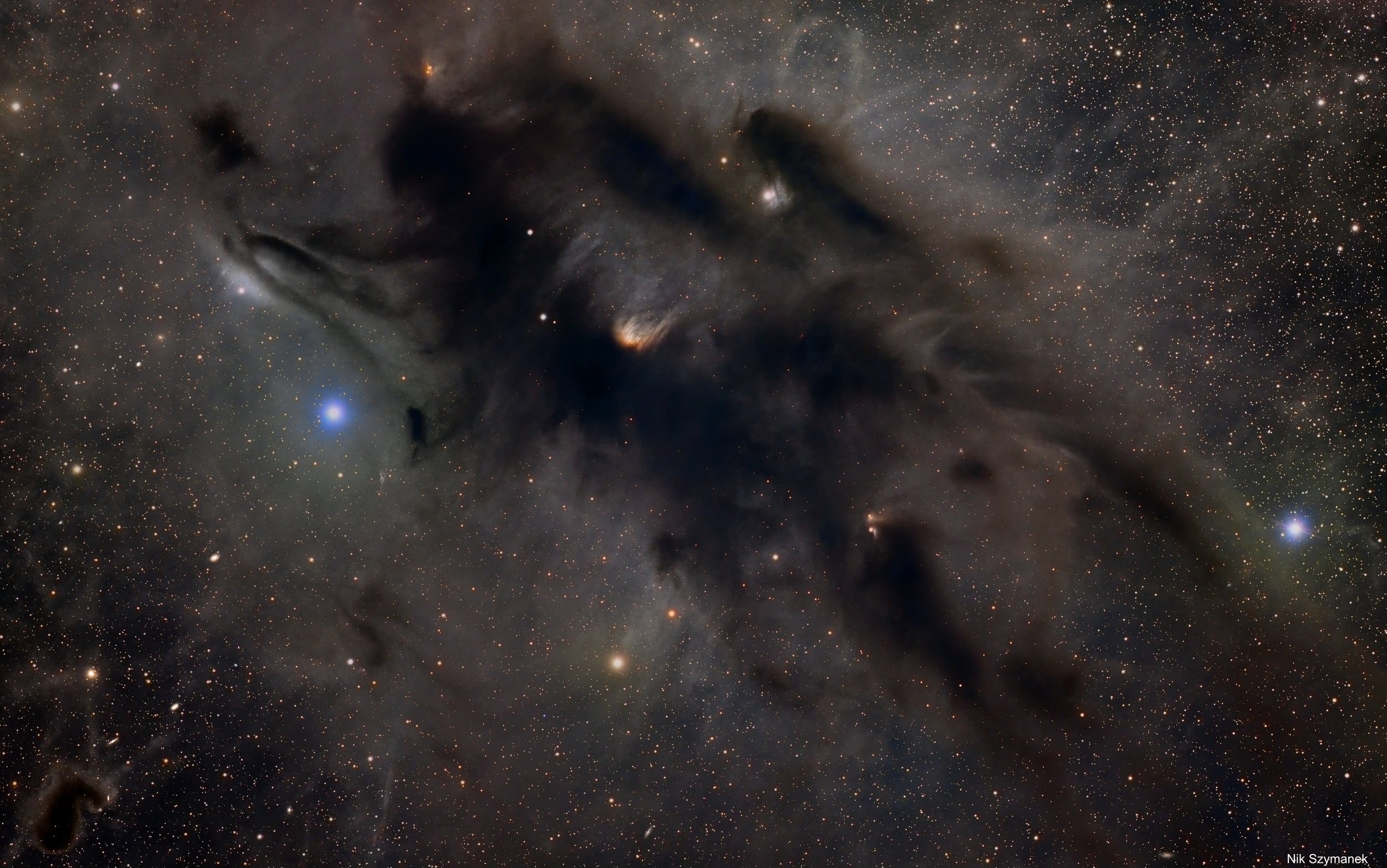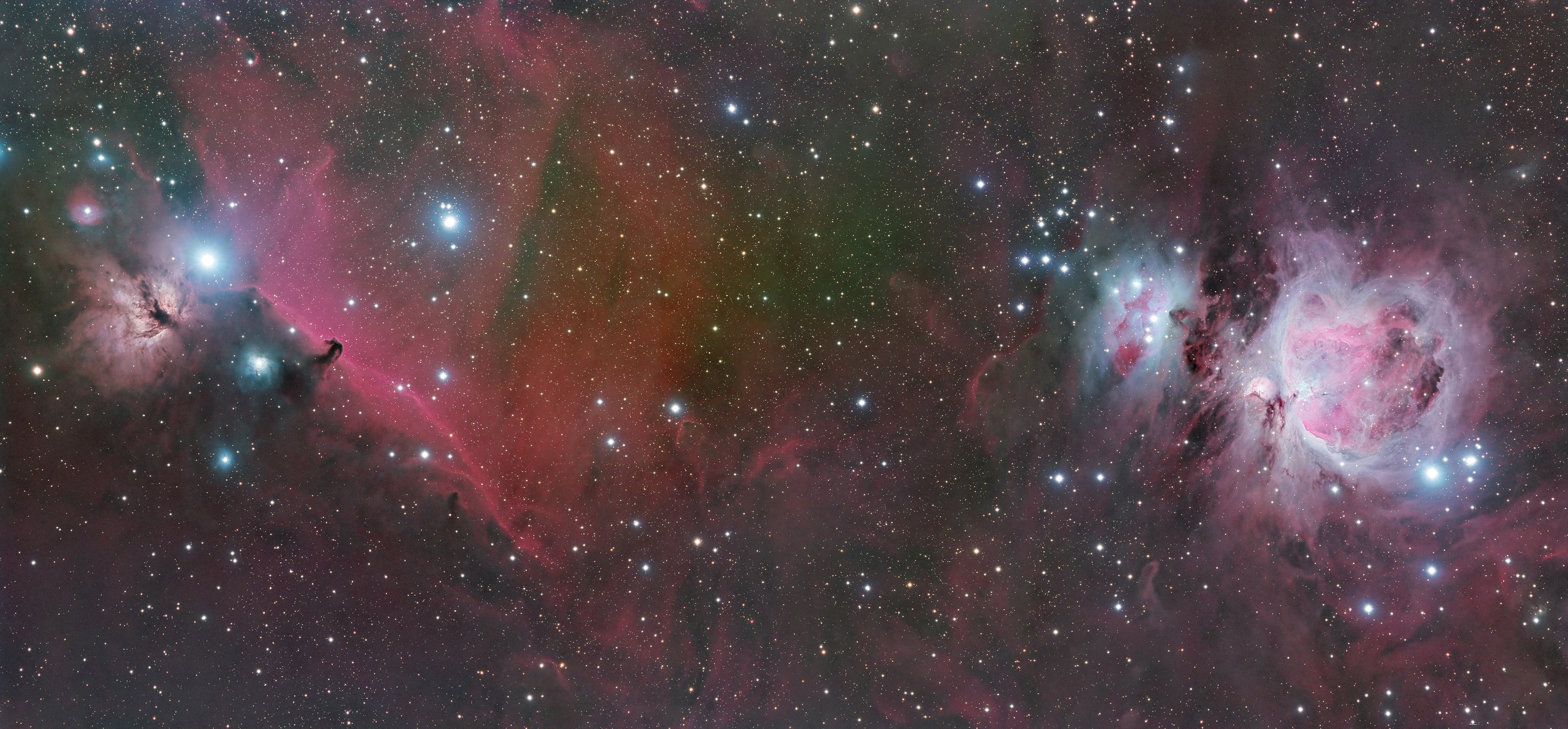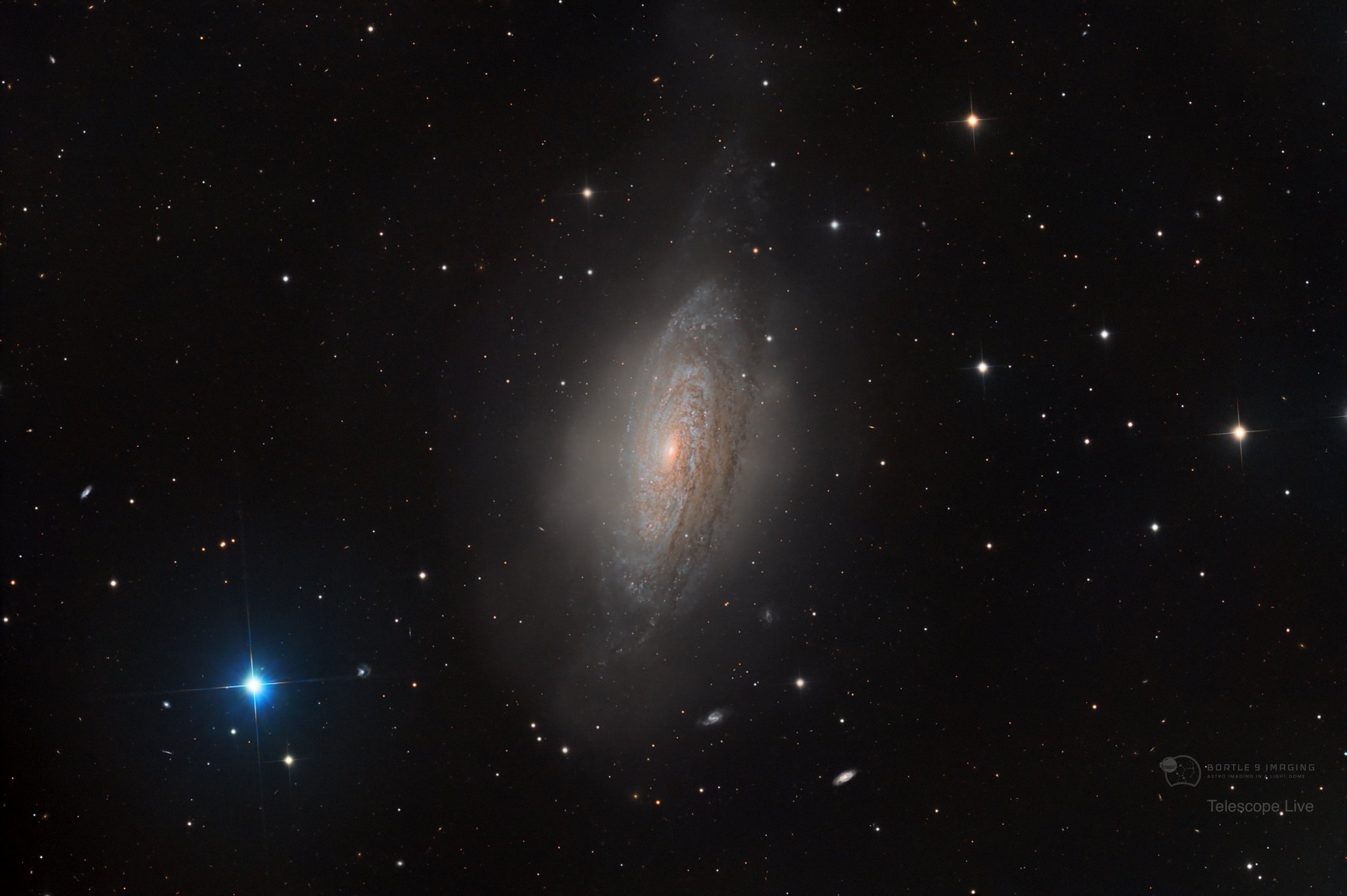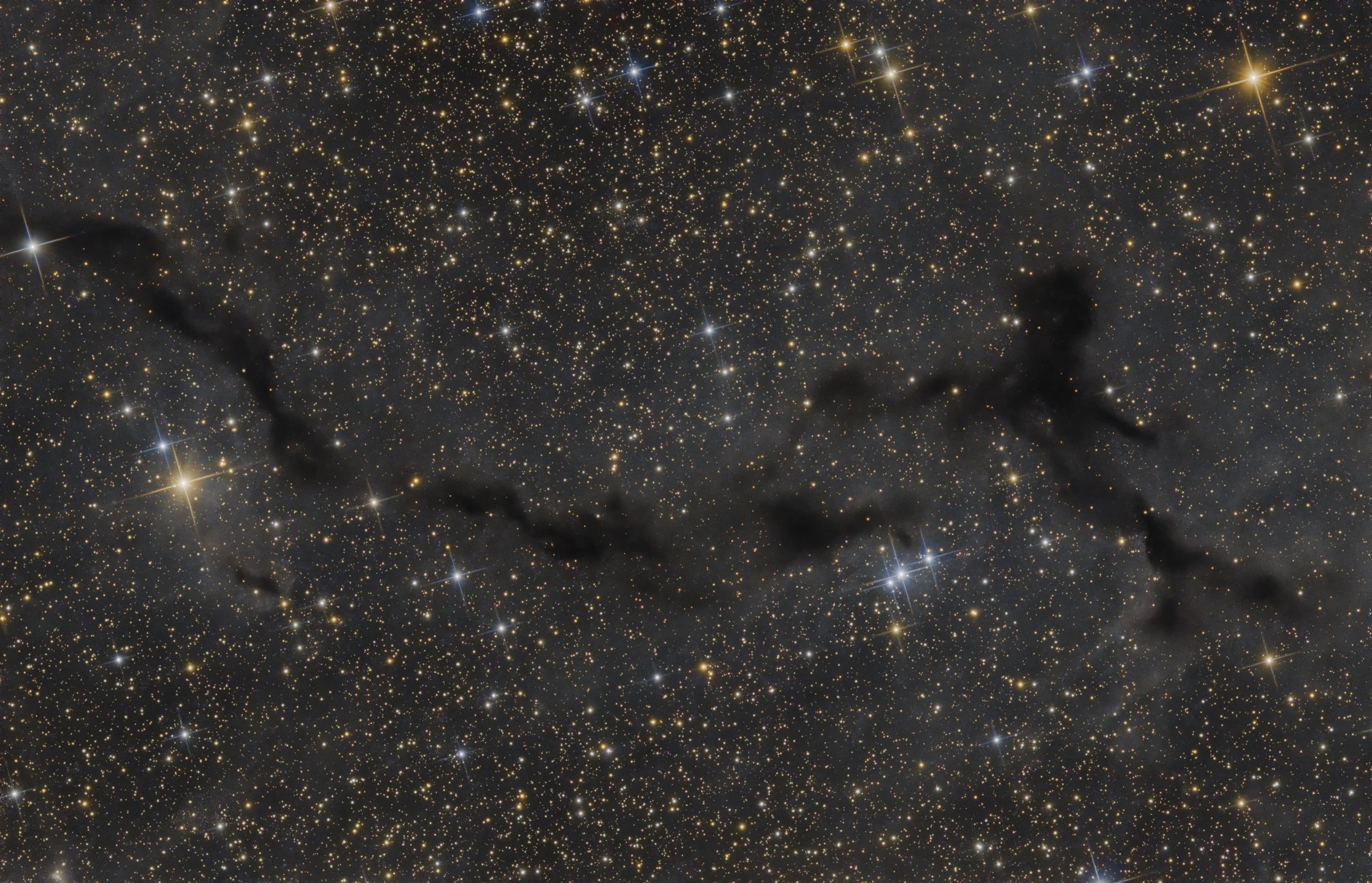
AAPOD2 Image Archives
Witch Head Nebula and Rigel - Ic 2118
The Witch Head Nebula, a striking interstellar apparition, adorns the night sky with its eerie silhouette in the constellation Orion. This enigmatic nebula, officially cataloged as IC 2118, owes its haunting appearance to the interplay of starlight and cosmic dust, giving rise to its distinctive witch-like profile.
Situated about 900 light-years away from Earth, the Witch Head Nebula is illuminated by the brilliant star Rigel, one of the brightest stars in the constellation Orion. Rigel's intense ultraviolet radiation energizes the surrounding hydrogen gas, causing it to fluoresce and emit a ghostly blue glow. Meanwhile, the dark tendrils of dust within the nebula absorb and scatter the starlight, casting eerie shadows that evoke the image of a witch's profile against the cosmic canvas.
Tarantula Nebula
The Tarantula Nebula, also known as 30 Doradus, stands as a celestial marvel within the confines of the Large Magellanic Cloud, a satellite galaxy of our Milky Way. This colossal stellar nursery spans over 600 light-years and dazzles observers with its vibrant colors and intricate structures.
At the heart of the Tarantula Nebula lies the massive star cluster R136, home to some of the most massive and luminous stars known to science. These young, hot stars ionize the surrounding hydrogen gas, causing it to glow with an ethereal brilliance that permeates the nebula's expanse. Amidst the cosmic chaos of the Tarantula Nebula, new stars are born in a dazzling display of stellar birth and evolution.
The Tarantula Nebula serves as a cosmic laboratory, offering astronomers insights into the processes of star formation and the dynamics of massive star clusters. Its proximity to Earth and its sheer size make it a prime target for scientific study, providing valuable data that enhances our understanding of the lifecycle of stars and the evolution of galaxies. As we gaze upon the Tarantula Nebula, we are reminded of the beauty and complexity of the cosmos, inspiring wonder and awe at the vastness of the universe and the mysteries that lie within.
NEW DISCOVERY: Strottner-Drechsler 33
New Discovery!
This first colour image of the probable planetary nebula StDr33 (PNG 201.6+03.9) shows a bright ring-shaped structure surrounding a whitish central star.
The central star is probably a close binary system in which two stars orbit each other. This is likely also the reason why the central star does not have the typical blue colour, as the spectral colours of both stars mix to a white-yellow. A total of 99 hours 25 minutes total integration (HaOIIIRGB)
Horsehead in OHS
The Horsehead Nebula, also known as Barnard 33, stands as an iconic silhouette against the backdrop of the Orion Molecular Cloud Complex. This dark nebula, situated in the constellation Orion, captivates the imagination with its distinctive shape resembling that of a horse's head, immortalized against the glowing backdrop of the emission nebula IC 434.
Located approximately 1,500 light-years away from Earth, the Horsehead Nebula owes its striking appearance to the interplay of cosmic dust and starlight. The dark dust clouds obscure the light from background stars, creating a stark contrast against the vibrant emissions of nearby hydrogen gas. Despite its haunting beauty, the Horsehead Nebula serves as more than just a celestial spectacle; it also serves as a stellar nursery, where new stars are born amidst the cosmic clouds.
Sunspot AR3576
Sunspots, dark blemishes on the surface of the Sun, offer a fascinating glimpse into the dynamic processes occurring within our nearest star. These cooler regions, caused by intense magnetic activity, punctuate the solar surface, creating intricate patterns that evolve over time.
Sunspots are often associated with solar flares and coronal mass ejections, powerful eruptions of energy and matter that can impact space weather and Earth's magnetic field. By studying sunspots, astronomers can gain valuable insights into the Sun's magnetic field and its influence on solar activity.
The number and distribution of sunspots follow an 11-year cycle known as the solar cycle, reflecting the waxing and waning of solar magnetic activity. During periods of high solar activity, sunspot numbers increase, while during periods of low activity, sunspots become scarce.
Despite their diminutive size compared to the vastness of the Sun, sunspots play a significant role in shaping the solar environment and are key indicators of the Sun's ever-changing nature. Studying these enigmatic features not only enhances our understanding of solar dynamics but also contributes to our ability to forecast space weather and its potential impacts on technology and infrastructure here on Earth.
NGC 1491 and PN Ou1
Nestled within the constellation of Perseus, NGC 1491 emerges as a celestial masterpiece, showcasing the intricate beauty of stellar birth and evolution. This emission nebula, illuminated by the energetic radiation of newborn stars, paints a vibrant portrait against the backdrop of the cosmic expanse.
At the heart of NGC 1491 lies a stellar nursery, where dense clouds of gas and dust collapse under their own gravity, giving birth to new generations of stars. The intense ultraviolet radiation emitted by these young stars ionizes the surrounding gas, causing it to glow with ethereal hues of red and blue. NGC 1491 serves as a stellar crucible, where the forces of creation sculpt the cosmic landscape, offering astronomers a window into the dynamic processes shaping our galaxy.
PNOU1: Exploring the Cosmic Mysteries in the Veil Nebula
PNOU1, nestled within the intricate filaments of the Veil Nebula, presents a fascinating glimpse into the aftermath of stellar death. This planetary nebula, born from the remnants of a dying star, showcases the intricate dance of gas and dust as it expands into the surrounding interstellar medium.
As the outer layers of the progenitor star are expelled into space, they form a luminous shell of ionized gas, illuminated by the fading light of the central remnant. PNOU1 represents a fleeting cosmic moment, a testament to the life cycle of stars and the transformative power of stellar winds and supernova explosions. Studying PNOU1 provides astronomers with valuable insights into the final stages of stellar evolution and the complex dynamics of interstellar matter, enriching our understanding of the cosmic tapestry woven across the vastness of space.
IC 2087 and Taurus Molecular Cloud
IC 2087 stands as a shadowy sentinel amidst the celestial expanse, a dark nebula shrouded in mystery and intrigue. Located within the boundaries of the constellation Taurus, this enigmatic cosmic cloud serves as a cosmic veil, obscuring the light of distant stars and revealing the intricate interplay of cosmic dust and gas.
As a dark nebula, IC 2087 offers astronomers a unique opportunity to study the processes of star formation and the dynamics of interstellar matter. Within its dense folds of dust and gas, new stars may be slowly emerging, their faint light struggling to pierce the veil of darkness. While its secrets remain largely hidden from view, IC 2087 beckons the curious gaze of astronomers, inviting them to unravel the mysteries of cosmic evolution and the birth of stars within the vastness of the cosmos.
Not Your Father's M39
Nestled within the constellation of Cygnus, M39 emerges as a stellar oasis amidst the celestial expanse, offering a captivating glimpse into the beauty and diversity of the cosmos. Comprising a collection of approximately 30 to 40 stars, this open star cluster presents a dazzling array of stellar luminosity against the dark backdrop of space.
At a distance of about 800 light-years from Earth, M39 serves as a stellar laboratory for astronomers, providing valuable insights into the formation and evolution of stars within our Milky Way galaxy. Its relatively young age of around 300 million years adds to its scientific allure, as researchers study the intricate dynamics of stellar birth and development within this celestial gathering. As observers peer into the heart of M39, they are invited to contemplate the vastness of the cosmos and the countless wonders that await exploration beyond the confines of our terrestrial realm.
Barnard's Merope IC349, inside Merope NGC1435 in the Pleiades
Amidst the cosmic tapestry of the Pleiades star cluster, the ethereal beauty of Barnard's Merope, designated IC 349, unfolds as a delicate nebular veil draped around the celestial jewel Merope. This intricate scene captures the interplay of interstellar dust and starlight, creating a celestial spectacle that graces the Pleiades with a touch of cosmic elegance.
IC 349, a reflection nebula, mirrors the radiant glow of Merope, one of the Seven Sisters within the Pleiades cluster. The nebular veils, illuminated by the star's brilliance, add a subtle celestial adornment, enhancing the visual richness of this stellar ensemble. As astronomers gaze upon Barnard's Merope, they witness not only the aesthetic charm of interstellar dust but also the scientific significance embedded in the delicate dance between starlight and cosmic particles. This cosmic tableau serves as a testament to the intricate relationships within star clusters, offering a glimpse into the astrophysical processes that shape and adorn our celestial surroundings.
Loop prominence
In the dynamic theater of the solar atmosphere, a captivating image captures the intricate dance of a solar loop prominence, adding a dramatic flair to the ever-changing canvas of our sun. This celestial ballet unfolds in the chromosphere, where magnetic forces sculpt vast arches of hot, ionized gas that leap and twirl against the solar disk.
This particular solar loop prominence, suspended by magnetic fields, manifests as a luminous arc reaching out from the sun's surface. The image not only showcases the aesthetic beauty of this solar feature but also provides a glimpse into the underlying astrophysical processes at play. As charged particles traverse magnetic highways, their graceful choreography is frozen in time, revealing the intricate dynamics that shape the sun's outer layers. Observing such solar phenomena not only captivates the eye but also deepens our understanding of the sun's complex and ever-active nature, highlighting the delicate balance between gravitational forces and magnetic influences on our closest stellar neighbor.
Old dried trees and this amazing view of the Cygnus constellation
In the quiet solitude of ancient, gnarled trees, a celestial spectacle unfolds as the Cygnus constellation graces the night sky with its timeless elegance. Against the backdrop of old, dried branches, this captivating view presents a harmonious blend of natural elements and cosmic beauty.
The Cygnus constellation, marked by the distinctive Northern Cross asterism, becomes a celestial companion to the weathered trees, casting its stellar glow amidst the earthly silhouette. The juxtaposition of the timeless landscape and the cosmic ballet above creates a scene that transcends epochs, inviting observers to marvel at the enduring interplay between the terrestrial and the celestial. As stargazers absorb the ethereal ambiance of this scene, they are reminded of the profound connection between the ancient narratives etched in terrestrial landscapes and the enduring allure of the cosmic realms above.
NGC 1977: “Running Man” nebula
In the cosmic ballet of the Orion Molecular Cloud Complex, the Running Man Nebula, designated NGC 1977, emerges as a celestial masterpiece that seamlessly blends elegance and dynamism. This intricate nebula, situated in the vicinity of the iconic Orion Nebula, captures the imagination with its wispy tendrils of gas and dust, resembling a celestial figure in perpetual motion.
As part of the larger Orion Complex, NGC 1977 is a reflection nebula illuminated by the luminosity of nearby stars. The interplay of stellar radiation with the surrounding cosmic medium results in the ethereal glow that characterizes this cosmic tapestry. In the cosmic theater, the Running Man Nebula invites observers to appreciate not only its aesthetic charm but also the astrophysical processes at play. As astronomers delve into the scientific intricacies of NGC 1977, they uncover insights into the complex dynamics of star formation and the interstellar environment, turning this celestial portrait into a gateway for both artistic appreciation and scientific exploration in the expansive canvas of the cosmos.
The sword of Orion in a 3 panel mosaic
In the celestial tapestry of Orion, the Sword of Orion unfolds in a captivating 3-panel mosaic, featuring the iconic Orion Nebula (M42), the Flame Nebula (NGC 2024), and the Horsehead Nebula (Barnard 33). The Orion Nebula (M42) takes center stage, a stellar nursery aglow with the radiant energy of young stars. Adjacent, the Flame Nebula (NGC 2024) adds its fiery glow, showcasing the dynamic interplay between stellar radiation and the surrounding cosmic medium. Completing the trio, the enigmatic Horsehead Nebula (Barnard 33) casts its shadow against the Orion Molecular Cloud Complex, a dark silhouette sculpted by cosmic forces. As observers delve into this 2-panel mosaic, they embark on a visual journey seamlessly intertwining the artistic allure of nebular landscapes with the scientific exploration of stellar birth and cosmic evolution.
This celestial diptych not only captivates the eye but also beckons the curious mind to explore the astrophysical intricacies embedded in the heart of Orion. As astronomers and stargazers navigate the cosmic expanse, the Sword of Orion stands as a testament to the harmonious convergence of artistic beauty and scientific inquiry in the realm of stellar landscapes.
M106
In the astronomical tapestry of Canes Venatici, M106 emerges as a captivating spiral galaxy, beckoning the gaze of astronomers and stargazers alike. This celestial beauty, also known as NGC 4258, unveils its intricate spiral arms and luminous core in a display of cosmic grandeur. M106 belongs to the relatively nearby M94 Group of galaxies, adding to the cosmic richness of this corner of the universe.
Situated approximately 23.5 million light-years away, M106 offers a unique opportunity for scientific exploration. Astronomers have probed its core, discovering a supermassive black hole that fuels powerful jets emanating from the galactic center. The interplay of gravitational forces and cosmic phenomena within M106 provides a canvas for unraveling the mysteries of galactic dynamics and the profound influence of supermassive black holes on their cosmic surroundings. As observers peer into the depths of Canes Venatici, M106 stands as a celestial testament, blending artistic beauty with scientific inquiry in the realm of spiral galaxies.
Alpha Persei Cluster
Within the celestial embrace of the Perseus constellation resides the Alpha Persei Cluster, a captivating open star cluster also known as the Perseus OB1 Association. Comprising a dazzling array of hot, luminous stars, this stellar ensemble serves as a celestial laboratory, offering astronomers valuable insights into the intricacies of star formation and the shared evolutionary trajectories of its brilliant members. Mirfak, the prominent Alpha Persei, commands attention as a radiant centerpiece, illuminating the surrounding stellar companions and contributing to the dynamic stellar tapestry that defines this cosmic gathering.
The Alpha Persei Cluster, with its diverse stellar population, invites observers to delve into the scientific nuances of its composition, revealing a harmonious interplay of varying star sizes and temperatures. This celestial dance, captured within the 2-panel mosaic, not only enchants the eye but also beckons the curious mind to explore the astrophysical intricacies embedded in the heart of Perseus. As astronomers and stargazers alike navigate the cosmic expanse, the Alpha Persei Cluster stands as a testament to the cosmic artistry and scientific fascination inherent in the study of open star clusters.
Standoff at the Border - Good Ghost, Bad Ghost - Two-Panel Mosaic
In the vast expanse of the night sky, a captivating 2-panel mosaic unveils the cosmic dialogue between LDN 1622, colloquially known as the Boogeyman Nebula, and the renowned Messier 78. On the left, the Boogeyman Nebula, a dark molecular cloud, draws the eye into the cosmic shadows where new stars quietly emerge, hidden from direct view but leaving an indelible mark on the celestial tapestry. The enigmatic interplay of light and shadow within LDN 1622 paints a cosmic portrait, enticing observers to explore the mysteries of stellar birth within its inky depths.
On the right, Messier 78 takes center stage—a reflection nebula illuminated by the borrowed radiance of nearby stars. Bathed in the scattered light of these celestial beacons, Messier 78 casts a luminous glow against the cosmic canvas. This celestial dance between darkness and brilliance, portrayed in the 2-panel mosaic, captures the essence of LDN 1622 and Messier 78, offering both a visual feast and an opportunity for scientific contemplation. As the observer navigates this cosmic juxtaposition, they are invited to appreciate the artistry of amateur astrophotography while delving into the scientific nuances that make these celestial entities captivating subjects in the realm of the night sky.
NGC 3521
NGC 3521, a captivating spiral galaxy residing some 26 million light-years away in Leo, showcases a mature spiral structure characterized by pronounced arms adorned with intricate dust lanes, a testament to the galaxy's advanced evolutionary stage. Notably, NGC 3521 stands out for its relatively low rate of star formation compared to peers, prompting astronomers to delve into the environmental and internal factors shaping its stellar populations.
At the heart of NGC 3521 lies a dense central bulge, a congregation of aging stars that bears witness to the galaxy's extensive cosmic journey. This feature offers a glimpse into the galactic spheroid's rich history and the complex interplay of astrophysical forces governing its stellar dynamics. As astronomers unravel the mysteries within NGC 3521, they navigate a scientific frontier, exploring the unique characteristics that define this spiral marvel and shedding light on the diverse pathways of galactic evolution in the cosmic tapestry.
Barnard 150
Bernard 150, nestled within the expansive cosmic tapestry, stands as a testament to the dynamic processes shaping our galactic neighborhood. This astronomical structure, intricately detailed in this image, reveals a symphony of interstellar elements at play, including ionized gases, dark dust lanes, and the luminous glow of newborn stars.
The complexity of Bernard 150 extends beyond its visual appearance, as astronomers delve into the scientific intricacies of its formation and evolution. Stellar winds, radiation pressure, and gravitational interactions contribute to the ever-changing dynamics within the nebula, creating a celestial ballet that unfolds over cosmic timescales.
Cheshire Cat (gravitational lens)
The Cheshire Cat Gravitational Lens is a result of a cosmic dance between massive objects, where the gravitational pull of a foreground galaxy acts as a cosmic magnifying glass, bending and distorting the light from a more distant galaxy located behind it. This gravitational lensing phenomenon creates a captivating optical illusion reminiscent of the elusive grin of the Cheshire Cat.
The Cheshire Cat Gravitational Lens introduces observers to the concept of gravitational lensing—a gravitational phenomenon predicted by Einstein's theory of general relativity. This celestial cat's grin serves as a visual reminder of the profound influence of gravity on the paths that light takes through the vast expanse of space.
Dolphin Head Nebula (Sh2-308) : A Morocco-Chile connection
Sh2-308 emerges as a stellar nursery, where a symphony of ionized gas and dust paints a celestial portrait against the backdrop of Aquila's cosmic expanse. The nebula's intriguing moniker, the Dolphin Head Nebula, stems from its distinct shape, which bears a resemblance to the playful form of a leaping dolphin against the canvas of the night sky.
The Dolphin Head Nebula comes to life through the brilliance of newborn stars illuminating the surrounding interstellar medium. The interplay of light and shadow within the nebula's intricate structure weaves a tale of stellar birth and the ongoing dance of cosmic forces.
Situated approximately 5,000 light-years away, Sh2-308 stands as a testament to the vast and dynamic nature of our galactic neighborhood. As observers gaze upon this celestial dolphin, they are reminded of the boundless creativity at play in the cosmos, where nature's artistry manifests in the intricate details of a nebular realm.



